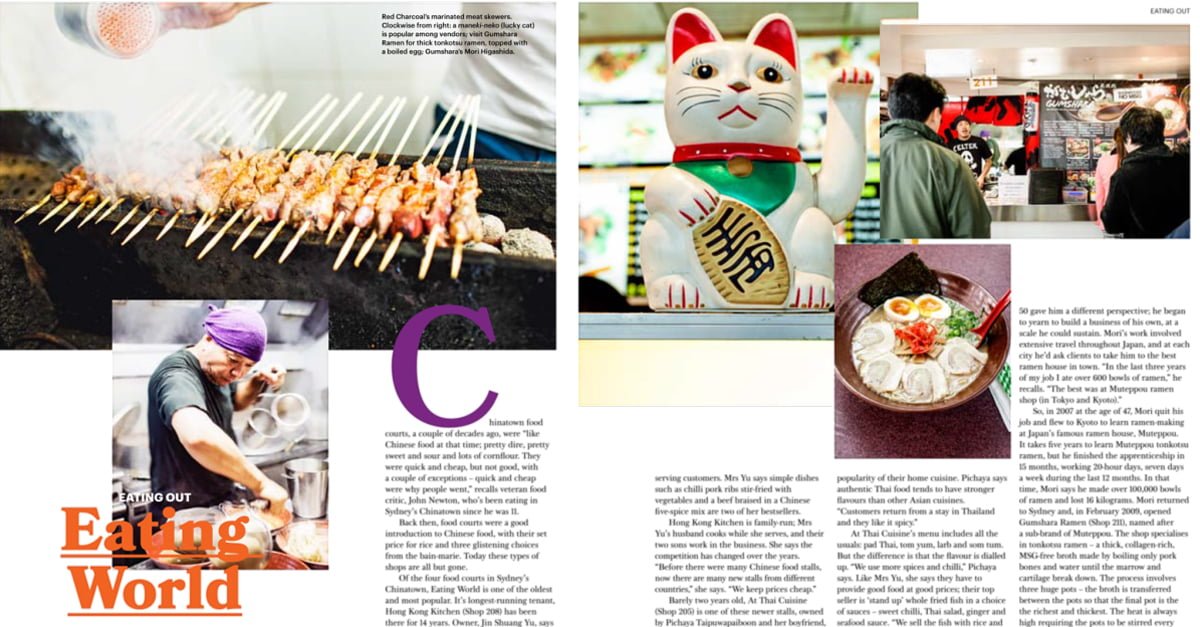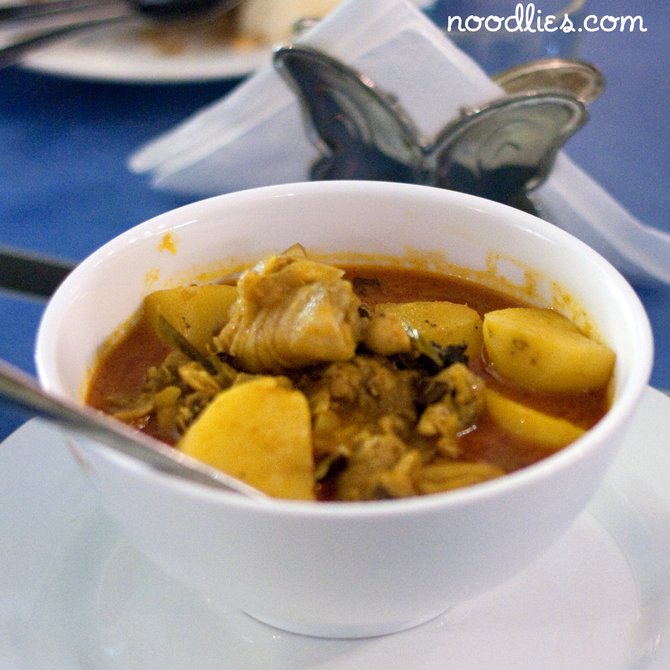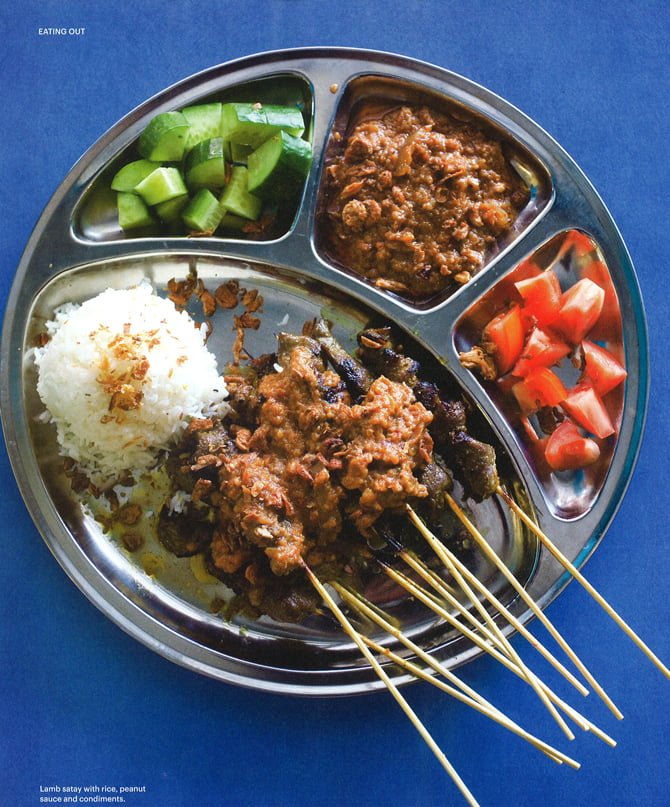Eating Out: Eating World
Issue 29, March 2014, by Thang Ngo
The vendors at Eating World in Sydney’s Chinatown are catering to a new wave of food appreciation sweeping across the nation’s Asian food courts as customers demand more traditional home-style dishes.
Chinatown food courts, a couple of decades ago, were “like Chinese food at that time; pretty dire, pretty sweet and sour and lots of cornflour. They were quick and cheap, but not good, with a couple of exceptions – quick and cheap were why people went,” recalls veteran food critic, John Newton, who’s been eating in Sydney’s Chinatown since he was 11.
Back then, food courts were a good introduction to Chinese food, with their set price for rice and three glistening choices from the bain-marie. Today these types of shops are all but gone.
Of the four food courts in Sydney’s Chinatown, Eating World is one of the oldest and most popular. It’s longest-running tenant, Hong Kong Kitchen (Shop 208) has been there for 14 years. Owner, Jin Shuang Yu, says you can still get the old favourites including lemon chicken, sweet and sour pork and Mongolian lamb, but these days, people want more traditional home-style dishes. “We cook like we eat at home,” she calls out between serving customers. Mrs Yu says simple dishes such as chilli pork ribs stir-fried with vegetables and a beef braised in a Chinese five-spice mix are two of her bestsellers.
READ: Best Chinatown Food Courts, Sydney
Hong Kong Kitchen is family-run; Mrs Yu’s husband cooks while she serves, and their two sons work in the business. She says the competition has changed over the years. “Before there were many Chinese food stalls, now there are many new stalls from different countries,” she says. “We keep prices cheap.”
Barely two years old, At Thai Cuisine (Shop 205) is one of these newer stalls, owned by Pichaya Taipuwapaiboon and her boyfriend, Weerawat Lorcharoenkit. Pichaya came to Australia from Chang Mai, Thailand to study hospitality and business management in 2006. To support their studies, the pair worked in restaurants in Sydney before realising the popularity of their home cuisine. Pichaya says authentic Thai food tends to have stronger flavours than other Asian cuisines.
“Customers return from a stay in Thailand and they like it spicy.”
At Thai Cuisine’s menu includes all the usuals: pad Thai, tom yum, larb and som tum. But the difference is that the flavour is dialled up. “We use more spices and chilli,” Pichaya says. Like Mrs Yu, she says they have to provide good food at good prices; their top seller is ‘stand up’ whole fried fish in a choice of sauces – sweet chilli, Thai salad, ginger and seafood sauce. “We sell the fish with rice and soup for only $10.50,” Pichaya says.
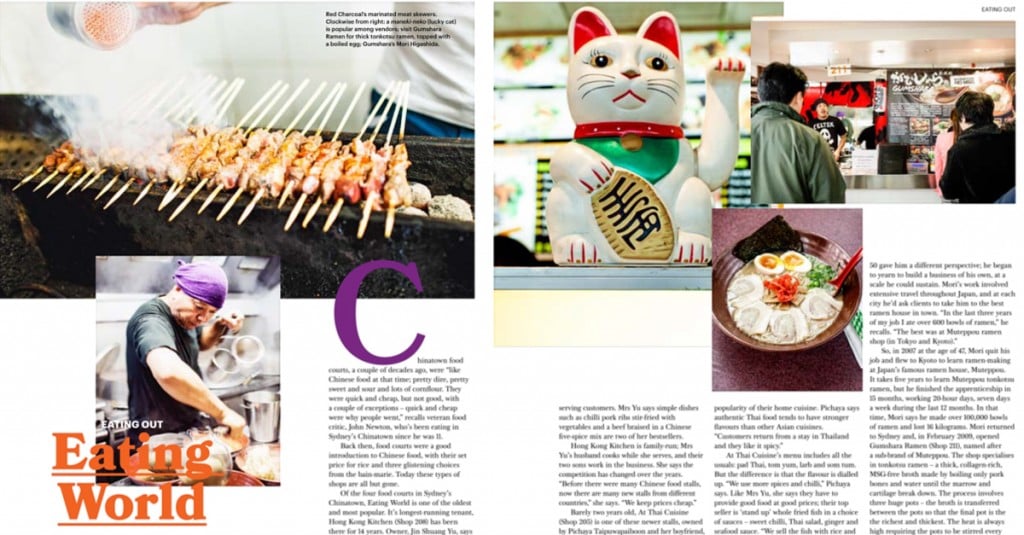
Mori Higashida had it all. For more than two decades, he’d worked his way up an Australian jewellery exporting business to become managing director. But approaching 50 gave him a different perspective; he began to yearn to build a business of his own, at a scale he could sustain. Mori’s work involved extensive travel throughout Japan, and at each city he’d ask clients to take him to the best ramen house in town. “In the last three years of my job I ate over 600 bowls of ramen,” he recalls. “The best was at Muteppou ramen shop (in Tokyo and Kyoto).”
On a busy day up to 200kg of pork bones (about five tonnes a month) are used.
So, in 2007 at the age of 47, Mori quit his job and flew to Kyoto to learn ramen-making at Japan’s famous ramen house, Muteppou. It takes five years to learn Muteppou tonkotsu ramen, but he finished the apprenticeship in 15 months, working 20-hour days, seven days a week during the last 12 months. In that time, Mori says he made over 100,000 bowls of ramen and lost 16 kilograms. Mori returned to Sydney and, in February 2009, opened Gumshara Ramen (Shop 211), named after a sub-brand of Muteppou. The shop specialises in tonkotsu ramen – a thick, collagen-rich, MSG-free broth made by boiling only pork bones and water until the arrow and cartilage break down. The process involves three huge pots – the broth is transferred between the pots so that the final pot is the the richest and thickest. The heat is always high requiring the pots to be stirred every three minutes. On a busy day up to 200kg of pork bones (about five tonnes a month) are used. For those wanting a lighter broth, Mori recommends Hakata ramen, which comes from the second pot.
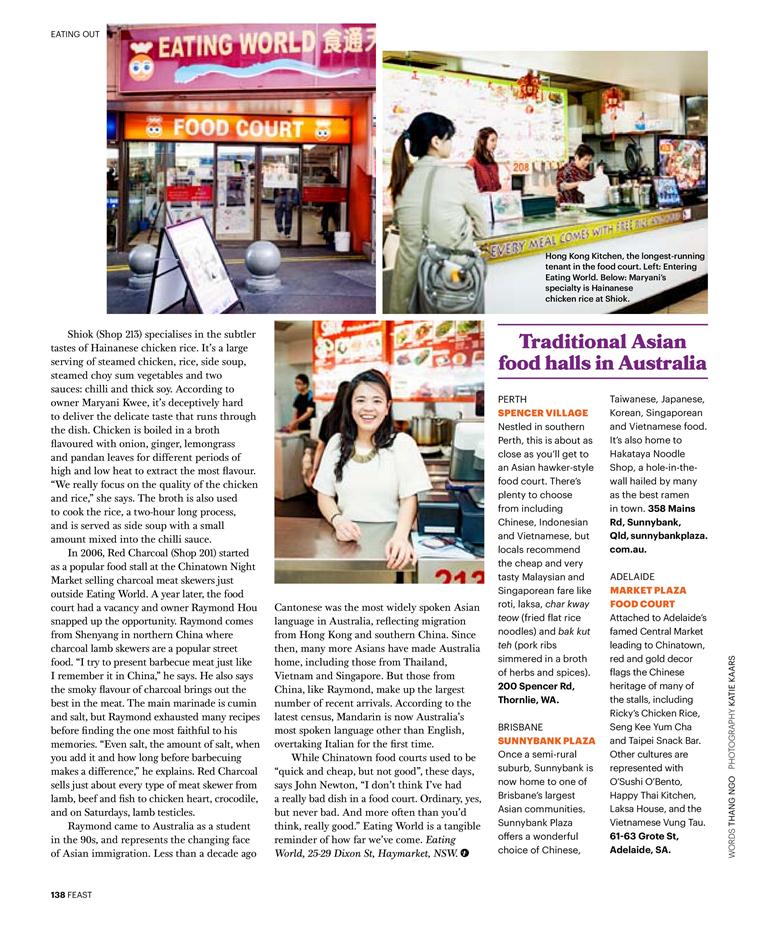
Shiok (Shop 213) specialises in the subtler tastes of Hainanese chicken rice. It’s a large serving of steamed chicken, rice, side soup, steamed choy sum vegetables and two sauces: chilli and thick soy. According to owner Maryani Kwee, it’s deceptively hard to deliver the delicate taste that runs through the dish. Chicken is boiled in a broth flavoured with onion, ginger, lemongrass and pandan leaves for different periods of high and low heat to extract the most flavour.
“We really focus on the quality of the chicken and rice,” she says. The broth is also used to cook the rice, a two-hour long process, and is served as side soup with a small amount mixed into the chilli sauce.
In 2006, Red Charcoal (Shop 201) started as a popular food stall at the Chinatown Night Market selling charcoal meat skewers just outside Eating World. A year later, the food court had a vacancy and owner Raymond Hou snapped up the opportunity. Raymond comes from Shenyang in northern China where charcoal lamb skewers are a popular street food. “I try to present barbecue meat just like I remember it in China,” he says. He also says the smoky flavour of charcoal brings out the best in the meat. The main marinade is cumin and salt, but Raymond exhausted many recipes before finding the one most faithful to his memories. “Even salt, the amount of salt, when you add it and how long before barbecuing makes a difference,” he explains. Red Charcoal sells just about every type of meat skewer from lamb, beef and fish to chicken heart, crocodile, and on Saturdays, lamb testicles.
While Chinatown food courts used to be “quick and cheap, but not good”, these days, says John Newton, “I don’t think I’ve had a really bad dish in a food court.
Raymond came to Australia as a student in the 90s, and represents the changing face of Asian immigration. Less than a decade ago Cantonese was the most widely spoken Asian language in Australia, reflecting migration from Hong Kong and southern China. Since then, many more Asians have made Australia home, including those from Thailand, Vietnam and Singapore. But those from China, like Raymond, make up the largest number of recent arrivals. According to the latest census, Mandarin is now Australia’s most spoken language other than English, overtaking Italian for the first time.
While Chinatown food courts used to be “quick and cheap, but not good”, these days, says John Newton, “I don’t think I’ve had a really bad dish in a food court. Ordinary, yes, but never bad. And more often than you’d think, really good.” Eating World is a tangible reminder of how far we’ve come. Eating World, 25-29 Dixon St, Haymarket, NSW.
Traditional Asian food halls in Australia
Perth
Spencer Village
Nestled in southern Perth, this is about as close as you’ll get to an Asian hawker-style food court. There’s plenty to choose from including Chinese, Indonesian and Vietnamese, but locals recommend the cheap and very tasty Malaysian and Singaporean fare like roti, laksa, char kway teow (fried flat rice noodles) and bak kut teh (pork ribs simmered in a broth of herbs and spices). 200 Spencer Rd, Thornlie, WA.
Brisbane
Sunnybank Plaza
Once a semi-rural suburb, Sunnybank is now home to one of Brisbane’s largest Asian communities. Sunnybank Plaza offers a wonderful choice of Chinese, Taiwanese, Japanese, Korean, Singaporean and Vietnamese food. It’s also home to Hakataya Noodle Shop, a hole-in-the wall hailed by many as the best ramen in town. 358 Mains Rd, Sunnybank, Qld, sunnybankplaza.com.au.
Adelaide
Market Plaza Food Court
Attached to Adelaide’s famed Central Market leading to Chinatown, red and gold decor flags the Chinese heritage of many of the stalls, including Ricky’s Chicken Rice, Seng Kee Yum Cha and Taipei Snack Bar. Other cultures are represented with O’Sushi O’Bento, Happy Thai Kitchen, Laksa House, and the Vietnamese Vung Tau. 61-63 Grote St, Adelaide, SA.

